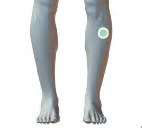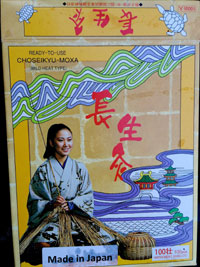Moxibustion, commonly called “moxa,” is one of the methods used in Traditional Chinese Medicine (TCM) where the downy fluff of the leaves of Artemisia vulgaris (mugwort) is burned directly on or near the skin of specific areas of the body. Mugwort is a member of the Asteraceae family. There are many subspecies in China, Japan and the US. It has analgesic, detoxifying, blood-moving and anti-parasitic properties. In moxibustion, mugwort is processed into a fine wool that can be shaped into cones or formed into rolls that burn quickly at a low temperature.
Moxibustion therapy may be even older than acupuncture, with its origins perhaps stemming from an accidental burn from a spark while sitting near an open campfire. At some time over the course of thousands of years, someone is likely to have experienced the relief of chronic symptoms such as arthritic or rheumatic conditions as a result of the exposure to heat. Moxa has been found to be effective for immuno-compromised, deficient diseases. I don’t think there is another treatment modality that surpasses the benefits that moxa can impart for deficiency diseases, especially diseases caused by a hypo-metabolic, Yang-deficient condition.
Types of Moxa
While there are many ways to use moxa, they all can be divided into two categories: direct and indirect. Direct moxibustion is when a small amount of the herb is burned directly on the skin over selected acupoints or areas of the body. Indirect moxibustion uses moxa rolled into sticks burnt and moved over specific points or areas of the body. For the purposes of the general use recommended in this article, I recommend using only indirect moxibustion.
Another method that is a step between between indirect and direct moxibustion is the use of stick-on moxa. These are individual pre-formed moxa cones fastened to an adhesive base. When lit and applied to the body, these are burned all the way down, depending on the sensitivity of the patient. Because the moxa herb burns out a few millimeters above the skin, it is not likely to cause a burn or blister in most individuals. (There are several different brands of stick-on moxa cones, but the one that I prefer is Chosei-Kyu, Ibuki stick-on moxa.)
Direct, semi-direct stick-on moxa, or indirect moxa produces degrees of sensation depending on the method and intention of the user. One can use moxa to create a generally warming sensation. Or, one can allow it to burn until one briefly feels a sharp zing, which is considered to be energetically the most powerful approach for moxa.
Uses for Moxibustion
From a TCM perspective, both acupuncture and moxibustion exert therapeutic effects through the vascular and neurologic circulatory systems. However, “moxibustion gives as well as moves,” while acupuncture with needles only “moves.” When treating deficient people only with needles, they may be too weak to mount a strong positive response. However, when treating with moxibustion, it not only stimulates circulation but it gives energy in the form of heat to the areas where it is applied.
Moxa is one of the most effective methods to relieve spasm and pain. There is an active debate between those in the West who advocate ice to prevent and relieve pain and TCM practitioners who feel that moxa is more permanently effective. Personally, I’ve found the latter to be true but if in doubt, one can first apply an ice pack to treat acute pain and later use moxibustion to effect a more lasting result.
 Stomach 36
Stomach 36
I believe that just as the medicinal properties of common herbs and weeds found in our environment is our birthright, I believe that the use of at least a handful of common acupoints falls into the same category. Today I’d like to introduce you to the most important acupoint on the body, Stomach 36. It is called Tsu San Li, translated as “Leg Three Miles.” The name comes from the ancient belief that one exhausted from walking such a long distance that they don’t feel they can take another step, can stimulate this point and go another three miles. This belief is so firmly entrenched in Chinese and Japanese folklore that in Japan, where walking long distances was simply the way that people got around, one is cautioned to not undertake such an arduous journey with another who did not first stimulate their Stomach 36 point.
Stomach 36 has so many uses that it is sometimes called “the point of 100 diseases.” It increases energy, stimulates the immune system, warms the body, treats diseases of the legs, waist, nervous and uro-genital systems, allergic and respiratory diseases and generally physical and mental weakness. While moxibustion on this point may be used on someone with mild hypertension, it is contraindicated for use in acute hypertension.
Finding Stomach 36
To accurately locate Stomach 36, measure four fingers of one hand from the bottom of the knee-cap along the outside margin of the fibula. You should notice a depression at this spot and that is Stomach 36. In general each point should be stimulated for approximately 5 to 10 minutes and there should be a reddening of the skin in the area. Watch a demonstration of moxa on Stomach 36 here.
Doing Moxa at Home
Moxibustion can be self-applied. Before beginning, be sure you are in a well ventilated space. Have a match, lighter or candle to ignite the moxa stick, a non-flammable plate to periodically tap the ashes onto, and a bit of tinfoil to wrap around the tip to snuff it out upon completion of the session. The unused portion of the moxa cigar can be reused until it can no longer be held.
After briefly teaching them how to treat themselves, I commonly send my patients home with a moxa stick and directions on how to warm up Stomach 36 or some other select acupoint. This works wonders on patients undergoing severely debilitating treatments such as chemo-radiation therapy. It not only revives the patient’s energy, but with increased circulation and vitality, their body is better able to utilize the intended benefits of such therapies. This can be done once or twice a week and more often if one is suffering from a disease associated with chronic weakness and deficiency.
In moxibustion, burns can occur accidentally or in a some instances deliberately. Believe it or not, this only makes for a stronger treatment. Not that one should begin by inflicting blisters with the early attempts at self-moxibustion, but if by chance one occurs, the immune response that occurs over a small point has a generally positive effect on the immune system overall. A blister should just be kept clean and covered until it naturally heals.
Where to purchase moxa
Llhasa OMS carries all forms of moxa.
Moxa is even available from Ebay.
Chosei-Kyu, Ibuki stick on moxa. These are found online and can even be purchased on Amazon at http://amzn.to/13rwqSW
Moxa rolls are also available from various sources including Amazon at http://amzn.to/13rxmH2
If you want to try the nearly smokeless moxa cigars you can find these at http://amzn.to/13rxmH2. The only drawback I see from these is that, being charcoal of the herb, it takes a little longer to light. I recommend using a candle to ignite these.


Is moxibustion a treatment that herbal practitioners can include in their services, or does one need an accupuncture license?
This is one of the most amazing posts on the internet about moxibustion in regards to stomach 36. When it comes to moxibustion many people believe it will hurt them, but I am glad I am able to easily convince my patients truthfully.
Hello. Thank you for that information. It was very helpful. I am looking to burn my moxa sticks for unexplained fertility (advanced maternal age) I have been doing acupressure over these points but want to know if I can use the moxa sticks as well.
Ren 17
Large intestine 11
Stomach 36
Lung 7, kidney 6, spleen4 pericardium 6
Liver 3
Lung 1
Kidney 7
If so, do I massage the points then apply the heat or just go through all the points with pressure then separately apply heat to all the points? I am extremely interested but am having a hard time finding someone to teach me or ask questions too.